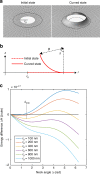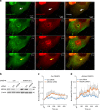Annexin A4 and A6 induce membrane curvature and constriction during cell membrane repair
- PMID: 29158488
- PMCID: PMC5696365
- DOI: 10.1038/s41467-017-01743-6
Annexin A4 and A6 induce membrane curvature and constriction during cell membrane repair
Abstract
Efficient cell membrane repair mechanisms are essential for maintaining membrane integrity and thus for cell life. Here we show that the Ca2+- and phospholipid-binding proteins annexin A4 and A6 are involved in plasma membrane repair and needed for rapid closure of micron-size holes. We demonstrate that annexin A4 binds to artificial membranes and generates curvature force initiated from free edges, whereas annexin A6 induces constriction force. In cells, plasma membrane injury and Ca2+ influx recruit annexin A4 to the vicinity of membrane wound edges where its homo-trimerization leads to membrane curvature near the edges. We propose that curvature force is utilized together with annexin A6-mediated constriction force to pull the wound edges together for eventual fusion. We show that annexin A4 can counteract various plasma membrane disruptions including holes of several micrometers indicating that induction of curvature force around wound edges is an early key event in cell membrane repair.
Conflict of interest statement
The authors declare no competing financial interests.
Figures







Similar articles
-
Annexins Bend Wound Edges during Plasma Membrane Repair.Curr Med Chem. 2020;27(22):3600-3610. doi: 10.2174/0929867326666190121121143. Curr Med Chem. 2020. PMID: 30663559
-
Interplay of membrane crosslinking and curvature induction by annexins.Sci Rep. 2022 Dec 29;12(1):22568. doi: 10.1038/s41598-022-26633-w. Sci Rep. 2022. PMID: 36581673 Free PMC article.
-
Heterogeneity and timing of translocation and membrane-mediated assembly of different annexins.Exp Cell Res. 2008 Mar 10;314(5):1039-47. doi: 10.1016/j.yexcr.2007.11.015. Epub 2007 Nov 29. Exp Cell Res. 2008. PMID: 18164291
-
Interdisciplinary Synergy to Reveal Mechanisms of Annexin-Mediated Plasma Membrane Shaping and Repair.Cells. 2020 Apr 21;9(4):1029. doi: 10.3390/cells9041029. Cells. 2020. PMID: 32326222 Free PMC article. Review.
-
Annexin A6 as a cholesterol and nucleotide binding protein involved in membrane repair and in controlling membrane transport during endo- and exocytosis.Postepy Biochem. 2018 Oct 25;64(3):190-195. doi: 10.18388/pb.2018_131. Postepy Biochem. 2018. PMID: 30656904 Review. English.
Cited by
-
Autoantibodies targeting TRIM72 compromise membrane repair and contribute to inflammatory myopathy.J Clin Invest. 2020 Aug 3;130(8):4440-4455. doi: 10.1172/JCI131721. J Clin Invest. 2020. PMID: 32687067 Free PMC article.
-
Membrane Repairing Capability of Non-Small Cell Lung Cancer Cells Is Regulated by Drug Resistance and Epithelial-Mesenchymal-Transition.Membranes (Basel). 2022 Apr 15;12(4):428. doi: 10.3390/membranes12040428. Membranes (Basel). 2022. PMID: 35448398 Free PMC article.
-
Annexin A4 Is Dispensable for Hair Cell Development and Function.Front Cell Dev Biol. 2021 Jun 3;9:680155. doi: 10.3389/fcell.2021.680155. eCollection 2021. Front Cell Dev Biol. 2021. PMID: 34150775 Free PMC article.
-
Encapsulation of protein/DNA complexes into unilamellar liposomes via annexin-mediated membrane recruitment and sonication.Cell Rep Methods. 2025 Jun 16;5(6):101073. doi: 10.1016/j.crmeth.2025.101073. Epub 2025 Jun 9. Cell Rep Methods. 2025. PMID: 40494358 Free PMC article.
-
Membrane-cytoplasm translocation of annexin A4 is involved in the metastasis of colorectal carcinoma.Aging (Albany NY). 2021 Mar 24;13(7):10312-10325. doi: 10.18632/aging.202793. Epub 2021 Mar 24. Aging (Albany NY). 2021. PMID: 33761465 Free PMC article.
References
Publication types
MeSH terms
Substances
LinkOut - more resources
Full Text Sources
Other Literature Sources
Miscellaneous

